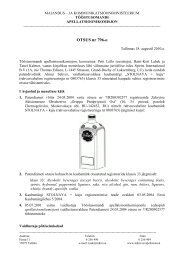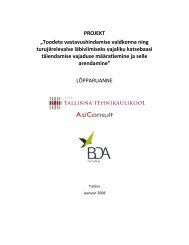Feasibility study for an Estonian Materials Technology Programme
Feasibility study for an Estonian Materials Technology Programme
Feasibility study for an Estonian Materials Technology Programme
Create successful ePaper yourself
Turn your PDF publications into a flip-book with our unique Google optimized e-Paper software.
83<br />
<strong>Feasibility</strong> <strong>study</strong> <strong>for</strong> <strong>an</strong> Estoni<strong>an</strong> <strong>Materials</strong> <strong>Technology</strong> <strong>Programme</strong><br />
4. Conclusions <strong>an</strong>d recommendations<br />
Why is a program needed – why not fund only separate projects? The program would create a<br />
better consensus of what areas are funded. Program m<strong>an</strong>agement could e.g. focus on international<br />
activities <strong>an</strong>d market the entity abroad. Possibility to collaborate with other national programmes.<br />
Facilitation could also enh<strong>an</strong>ce building new projects.<br />
Disadv<strong>an</strong>tage: More m<strong>an</strong>-years needed to decide which areas need support. Risk of getting too<br />
broad. The areas have to be focused. Risk of being on-top of existing programmes.<br />
To succeed: In the beginning it might be wise to start with smaller one-to-one projects <strong>an</strong>d in three<br />
years increase the number of industry partners in the projects. Needs true involvement of comp<strong>an</strong>ies<br />
<strong>an</strong>d a good facilitator to enh<strong>an</strong>ce the collaboration.<br />
3. <strong>Programme</strong> to distribute all funding given to fundamental research <strong>an</strong>d applied research funding<br />
in materials technology development<br />
Would be similar to the current Energy <strong>Technology</strong> program<br />
Benefit: determines how the funding in Estonia is allocated.<br />
The disadv<strong>an</strong>tage is the high-level of bureaucracy involved, including m<strong>an</strong>y m<strong>an</strong>-hours of work to find<br />
a consensus.<br />
Would require strong involvement of the industry to focus the program<br />
Problem: does the industry underst<strong>an</strong>d what it needs in long-term?<br />
Similar benefits as choice 2.<br />
With the trade-off that the entity is huge.<br />
The other question is who evaluates the excellence of fundamental research.<br />
There is a need to do more applied research. <strong>Programme</strong> could make funding <strong>for</strong> applied research more<br />
attractive <strong>an</strong>d easier to apply.<br />
Summary<br />
Benefit: There will be <strong>an</strong> entity that knows what kind of materials research is funded in Estonia.<br />
<strong>Programme</strong> could create better bal<strong>an</strong>ce between fundamental <strong>an</strong>d applied research.<br />
The true benefit of a materials technology program would be to create cross-disciplinary areas<br />
that result in new business areas where Estonia could have a competitive adv<strong>an</strong>tage. However,<br />
currently research <strong>an</strong>d development is facing the bigger problem of too little university-industry<br />
collaboration <strong>an</strong>d this should be solved first.<br />
Challenge: Huge entity. How to define the focus of the programme. How to define what kind of<br />
fundamental research should be funded. How does the program relate to the existing ones? How to<br />
make sure that the comp<strong>an</strong>ies are involved?<br />
Disadv<strong>an</strong>tage: Huge entity. Money distribution will be made very bureaucratic<br />
To succeed: The program has to have a focus. Otherwise no programme is needed.<br />
4. Supporting actions but no Program to distribute funding<br />
Research funding could be directed as is today, through ministries, Archimedes foundation, EAS etc.<br />
We highly recommend bigger but less projects with higher risk in addition to smaller applied research<br />
projects done in collaboration with comp<strong>an</strong>ies.<br />
Supporting actions could include<br />
Dissemination of research results to (m<strong>an</strong>ufacturing) industry (one-to-one discussions)<br />
<strong>Technology</strong> scouting <strong>for</strong> industry<br />
Workshops on specific topics mostly based on industry needs <strong>an</strong>d university results marketing.<br />
Business coaching to high-tech start-ups<br />
Facilitator could also give funding <strong>an</strong>d education guidelines to policy makers based on knowledge<br />
gathered from players.<br />
Facilitator should bring together different players <strong>an</strong>d activities, including different programs, industry<br />
associations, institutes etc.<br />
Facilitator could also make a detailed roadmap <strong>for</strong> certain areas of development together with the<br />
players to influence funding decisions.<br />
Reorg<strong>an</strong>izing education <strong>an</strong>d getting more industry projects during education is of great import<strong>an</strong>ce as<br />
well.<br />
In a couple of years, <strong>an</strong> import<strong>an</strong>t part of facilitation should be put on international activities <strong>an</strong>d<br />
partnering.<br />
Benefit: Less bureaucracy when distributing funding. Facilitator could concentrate on the supporting<br />
actions <strong>for</strong> which there is a huge need (e.g. enh<strong>an</strong>cing university-industry collaboration).<br />
Disadv<strong>an</strong>tage: Less connection to industrial needs in funding decisions <strong>an</strong>d less knowledge of the overall<br />
funding picture. If no funding is related to facilitation actions will they lose their effect?<br />
Challenge <strong>an</strong>d Big Risk: Will less funding be given to materials technology if there is no programme?





